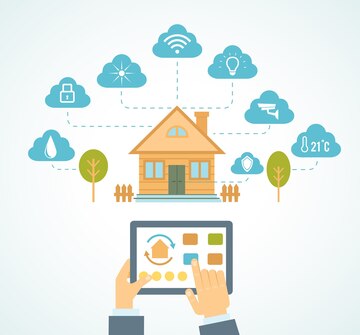The Best Way to Make Your Home Smart: First Choices
Best Way to Make your Home Smart - Building a smart home in 2025 does require some knowledge and self-learning. It could cost an arm and a leg, but it doesn't have to. You can build your way up.
What is a Smart Home?
A smart home is a comfortable and convenient house setting where home appliances and devices are interconnected over the internet or a network and can be controlled remotely.
Every device in the smart home communicates with every other device, allowing you to stay up-to-date while also keeping your devices updated. When you get out of bed, your smart coffee maker or lighting may turn on since they communicate with one other.
The Internet of Things sounds meaningless, but that is what happens: everything is connected, which means that your life is more manageable, and you don't have to perform all these mundane tasks.
Automated systems on a single network manage all of these connected devices. Thanks to intelligent apps and devices, you have an intelligent house. There's just one problem: Smart home gadget manufacturers are many, yet you need all these devices to speak to each other on one network.
The best way to make your home smart is to start small and have scalability in mind. In the future, as you buy more smart home gadgets, you need them to be compatible.

Smart Home Single Network Options
Zigbee, Z wave, Bluetooth, Insteon, or WIFI are ways you can have all your devices speak to each other. Make sure your internet service provider speeds are fast.
In addition, you need to choose from Apple's Home Kit, Amazon's Alexa, or Google Nest for wireless communication. Apple and HASS Home Assistant Smart System could be a good option if you have privacy concerns about how much data is collected from your home.
Home Assistant does not need a WIFI connection and works well over your local area network. Tinkerers or tech enthusiasts mostly use it.
You could also use a smart hub, but this is not a must.
How to Build a Smart Home System: Getting Started
Identify which voice assistant is best for you: Siri, Google Assistant, or Alexa. Alexa has the advantage of compatibility with many devices since they were the first in the market. However, their speakers are not so good. You summon Alexa by talking over the speakers,' Alexa, switch on the lights.'
'Ok. Google turn on the music.' Google's Artificial Intelligence is more intelligent since it uses the metrics of Google search. It can answer almost anything accurately, unlike Alexa, which sometimes gets confused.
The worry with Google Assistant is how much data it collects, poor audio, and less extensive compatibility, unlike Alexa.
Apple's Siri is exclusive to Apple products, iPhone, MacBook, which can be expensive unless you already use them. Just a handful of intelligent home accessories work with HomeKit. However, if you were using Apple devices, HomeKit would be the best option, and your privacy is guaranteed.
Pick your Hardware: Smart Home Devices that are Worth It
After settling on your voice assistant, you now buy your hardware Amazon Echo varieties such as Echo Plus, Echo dot, and so forth. Buy Google Home and get the latest android phones if you do not have one already. iPhone, Apple smartwatch, or an iPad will work well with Siri.
1. Upgrade your Lighting
Having lighting that anticipates your needs can be thrilling. You could get the sunset or that blue-white lighting you need to keep working for a little longer. Intelligent lighting will also save on energy by lighting up when there is someone in the room.
Many intelligent lighting systems don't require a central hub and can still communicate with other intelligent home devices, including speakers and displays like the Amazon Echo and Google Nest. For example, intelligent bulbs from LIFX and TP-Link use Wi-Fi to communicate, while Philips Hue bulbs communicate with your smartphone using Bluetooth.
Some systems necessitate using a bridge, which is a device that communicates with intelligent light via a Wi-Fi router.
Echo Dot, which comes with a free Sengled bulb, is the best option for those on a budget.
2. Smart Plugs
Smart plugs can switch your appliances on and off without your intervention. With the help of Google Assistant and Alexa, you can schedule when to switch on or off your fan, heater, coffee maker, or any other appliance.
3. Security Cameras
Get a wireless camera with a rechargeable battery, a microSD card, or free cloud storage if you are on a budget. Some cameras come with affordable cloud storage monthly plans.
Other things to consider are an intelligent doorbell with two-way communication for you to converse with visitors or the delivery guy, an intelligent thermostat to control room temperatures, and smart smoke detectors.
Final Submission
Getting started to make your home smart doesn't have to be boggling. With these baby steps and with the help of an ecosystem and voice assistant, you only have to build on your intelligent gadgets slowly.